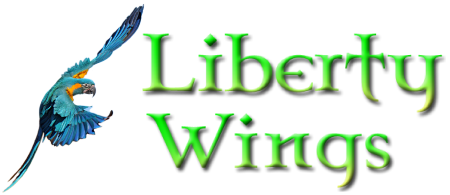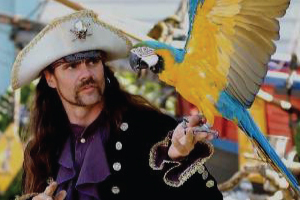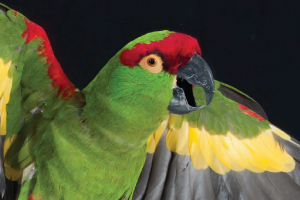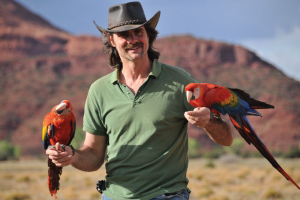Stimulus Control
Written By Chris Biro, Copyright 2008
Often people have problems with training one behavior because they have not yet finished training the previous behaviors they think they have already “trained”. Recall is just such a behavior that often gets only partially trained. Whether a behavior is fully trained or not is a question of how well you have established stimulus control. Stimulus control has several levels and each level is trained through its own step.
Step 1) Getting the animal to do the desired behavior at all. This is usually trained by any method necessary to get the bird to initially do the behavior. For recall training that would start out with getting the bird to fly to you for any reason.
Step 2) Getting the desired behavior to occur after being cued. Usually trained by offering the cue immediately prior to when you KNOW the behavior will occur. For recall this means that some time after you call the bird it will come to you.
Step 3) Getting a quick response to the cue. This is usually taught by a shaping routine where the quicker responses are always reinforced and/or more heavily and the really slow responses are not reinforced (or reinforced only occasionally) but the intermediate responses are still lightly reinforced. For recall the bird should immediately begin heading in your direction. I understand Steve Martin is really big on a “window of opportunity” to perform the behavior. The animal is offered the cue and has a certain amount of time to respond and earn the reinforcement. After that time expires, no reinforcement is offered for the behavior. And the cue is not offered again until some time later. This way the animal learns to offer the behavior immediately upon receiving the cue.
Step 4) The animal does the desired behavior only when properly cued and at no other time. This is usually trained by tightening the criteria so that ONLY correct responses are reinforced. This is one that I personally have for some time been uncomfortable with training my flighted birds. However, I am beginning to see that not training this step leads to confusion and overall poor performance. I always enjoyed that my birds often fly to me on their own volition and I would like them to continue to be able to do so. But what I think I need to do is to train them to have a “free time” cue that means they are free to do what ever they wish. The idea is to establish a clear “working mode” and a “free time mode”. I have had some trouble with Cosmo (B&G) at the fairs with this issue and can see how this would really help things out a lot. Cosmo has this tendency to want to fly to me constantly during the show but if I work to stop her during the show, she then feels uncomfortable flying to me at all. She does not understand that there are times flying to me uncued is ok and other times when it is not ok. Training a free time mode should help this.
For some people 100% recall means to them that they can get their bird back every time. They may be good at adjusting the antecedents to get the bird to do what they want but may not actually have good stimulus control. This is really more how I have worked with my birds. I am very good at manipulating the antecedents and as such have been bit lazy on establishing good stimulus control. After watching some good dog training I am convinced I need to get more serious about good stimulus control. I believe that such is equally trainable with our birds and is as immensely valuable to us owners of freeflighted birds as it is to owners of competitive dogs.
If your bird doesn’t understand the one cue/one response concept, placing them into a new environment will cause confusion over what is acceptable and what is not. Which time when you call do you really mean to come? What other conditions have to be met before you really mean it? Do you need to have treats visible, do you have to have the special target stick visible, have you been clicking other behaviors? This is like when people train their dogs to sit, and say “sit fido, sit, sit, sit” and then can not figure out why when they take their dog to a party, the dog will not sit when they say “sit fido”. Fido doesn’t understand ‘sit fido’ as a cue to sit (he probably has not generalized ‘sit’ to other locations yet either), he knows “sit fido, sit, sit, sit” (and only in certain familiar locations).
Training an animal to full stimulus control can be a lot of fun and it has many rewards. And the more often you do this, the easier it becomes. Not only will the trainer get better with his/her training skills but the animal will generalize the behavior of “Learning Stimulus Control” and “get it” more quickly.
Parrots: More Than Pets, Friends For LifeChris Biro
Resources and More
The Pirate's Parrot Show
An educationally based pirate-themed parrot show performing at state and county fairs since 1991. The Pirate’s Parrot Show is a Fun, Educational, and Interactive experience for all ages and cultures.
Bird Recovery International
One in every eight bird species in the world today is in danger of extinction and these numbers are increasing! Find out how this non-profit organization started by Chris Biro can help save and protect parrots and other birds.
Podcasts with Chris Biro
An Alternate Perspective – Enjoy these audio Podcasts of Chris with guests discussing the nature of training flighted birds. The discussions are intended to be loosely structured around a general topic.
Email Us
chris@libertywings.com
Call Us
(206) 618-2610
Contact Us
By Using the Contact Form




I have 2 adopted rescue ekkies. The male is an EXCELLENT flyer. He has been clipped but I intend to let his feather grow back in and fly him inside. I feel he is an excellent candidate for recall, however I have loaded the clicker, but I cannot get him to follow the stick for anything, not even lean over to touch it. He is not motivated by food, not even his favorite, peanuts. I have tried peanut butter and many other treats. He does not play with toys and does not want scratches. He does step up, which I taught him. He will not do it everytime on cue, even though I do reward him with a safflower seed every time. How can I get the ball rolling? Thanks for your article. ~Page
I would first recommend you read the article on the site about building interest in food rewards. it sounds like your bird has not learned the value of taking the food treat when it is presented. It may feel confident that food items will be available at any time so does not need to be interested in the food now. It may be that the food item you are using is not highly valued or only offered during training. I would limit access to this food item to training session only and I would look to use a food reward that is especially desired, favorite food item of all. I hope this helps. Chris